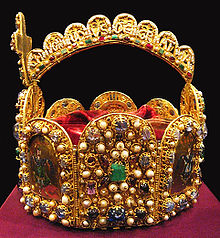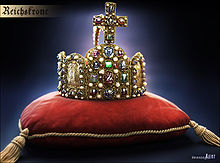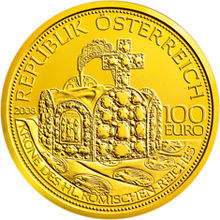- Imperial Crown of the Holy Roman Empire
-
The Imperial Crown (German: Reichskrone), is the hoop crown (German: Bügelkrone) of the King of the Romans, the rulers of the German Kingdom, since the High Middle Ages. Most of the kings were crowned with it. It was made probably somewhere in Western Germany, either under Otto I (with additions by Conrad II)[1], by Conrad II or Conrad III during the late 10th and early 11th centuries. The first preserved mention of it is from the 12th century — assuming it is the same crown, which seems very probable.
Along with the Imperial Cross (Reichskreuz), the Imperial Sword (Reichsschwert), and the Holy Lance (Heilige Lanze), the crown was the most important part of the Imperial Regalia (Reichskleinodien). During the coronation, it was given to the new king along with the sceptre (Reichszepter) and the Imperial Orb (Reichsapfel). The Imperial Regalia of the Holy Roman Empire, especially the Imperial Crown, were all kept 1424–1796 in Nuremberg, Franconia — and could only leave the city for the coronation.
Currently, the crown and the rest of the Imperial Regalia are exhibited at the Hofburg in Vienna — officially "until there is again a Holy Roman Emperor of the German Nation".[citation needed]
An identical copy is in Aachen in Germany in the Krönungssaal of Charlemagne's former palace, now town hall. There are also copies of the crown and regalia in the historic museum of Frankfurt, as most of the late Emperors where crowned in the cathedral of the city, as well in the fortress of Trifels in the Palatinate, where the Imperial Crown was stored in medieval times.
Contents
Appearance
The Imperial Crown does not look like most more modern crowns. The crown does not have a round shape, but an octagonal one. Instead of a ring, it has eight hinged plates which are rounded off at the top. Two strips of iron, riveted with golden rivets to the plates, hold the crown together and give it its octagonal shape. At what point these iron strips were installed is unknown. Before the addition of the rings the plates were held together by long golden pins thus making it possible to separate the plates and the arch for easier transport.
Each plate of the crown is made out of a high carat gold, around 22 carats, which gives the crown a "buttery" colour, and is studded with pearls and precious stones. The stones are not cut into facets (a technique still unknown when the crown was made), but rather polished into rounded shapes. This technique is an ancient one and gemstones like this are described as being "en cabochon", which are still made to this day. The pearls and the stones were put into openings that were cut into the metal, and fastened with thin wires. The effect was that when the light shone in, the stones looked as if they would shine from within.
The crown is decorated with 144 precious stones (including sapphires, emeralds and amethysts) (green and blue precious stones being proper to emperors in Byzantine imperial protocol) and about the same number of pearls. Similar gem-studded styles of decoration were used for the most precious objects of a number of types at this period, in particular processional or altar crosses such as the Cross of Lothair and book-covers such as that of the Codex Aureus of St. Emmeram.
Four smaller plates bear pictorial representations of figures and scenes from the Bible and inscriptions in cloisonné enamel, in the Byzantine style. The four plates, called 'picture-plates' (Bildplatten) each shows representations from the Old Testament. Each of these enamelled plates is surrounded by blue sapphires and pearls in raised filigree settings.
Front Right Plate — Christ enthroned as the Lord of Hosts between two cherubim[2] beneath the inscription in red enamel [PER] ME REGES REGNANT "By me kings reign" (Proverbs 8:15).
Back Right Plate — The Prophet Isaiah stands speaking to King Hezekiah who sits on his bed. Isaiah holds a scroll with the words, "Behold, I will add fifteen years to your life" (II Kings 20:6). Above both Isaiah and Hezekiah is the inscription in red enamel ISAIASEZ E IPHETACHIAE REX "Isaiah said to King Hezekiah."
Front Left Plate — King Solomon holding a scroll with the words, "Fear the Lord and flee from evil" (Proverbs 3:7), beneath an inscription in red enamel REX SALOMON "King Solomon."
Back Left Plate — King David holding a scroll with the words, "The renown king delights in doing justice" (Psalm 99:4), beneath the inscription in red enamel REX DAVID "King David."
The other four plates, called 'stone-plates' (Steinplatten), are of differing sizes and are decorated solely by precious stone and pearls in raised filigree settings. The twelve stones on the front and back plates are probably a direct reference to the twelve stones of the Jewish high priest's breastplate (cf. Exodus 39:9-14) and to the twelve foundation stones of the New Jerusalem in the Revelation to John (Cf. Revelation 21: 19-21).
The top central stone of the front plate is a triangular sapphire which replaces a famous stone, now lost, which was known as the Waise (i.e., the 'Orphan', because of its uniqueness), probably a large white opal with a wine-red fire or possibly a singularly brilliant garnet or red zircon and the subject of much legendary medieval lore. The medieval theologian and philosopher Albert the Great wrote about it in 1250:
The orphan is a jewel in the crown of the Roman emperor. Because the like of it has never been seen elsewhere it is called the "orphan". It has the color of wine, of delicate red wine and it is as if the dazzling, white of snow penetrates the bright wine red and yet it remains dormant in this redness. The gem shines powerfully and it is said that it once even shone at night, but not in our time, but it is said to preserve the honour of the empire.
How or why it was removed from the Imperial Crown is not known. The last mention of it is in a inventory ordered by Charles IV in 1350.
The crown has a single arch from from the front to back plate with the name and imperial style of Conrad II in seed pearls[3] On the left side of this arch these seed pearls spell out the words CHUONRADUS DEI GRATIA "Conrad, by the Grace of God", while on the right side they read ROMANORU (M) IMPERATOR AUG(USTUS) "Emperor of the Romans (and) Augustus". Above the front plate and in front of the arch is a jewelled cross, originally a pectoral cross said to have belonged to Henry II.[4] and only later attached to the Imperial Crown.[5] There are also three small holes on each of the two side stone-plates from which chains with pendant jewels, known as pendilia, like those still found on the Hungarian Holy Crown of St. Stephan probably hung.[6]
The present red velvet cap on the inside of the crown dates from the 17th century. Before this the imperial crown was worn over a miter. If originally the form of the miter the imperial crown was intended to be worn over had the form of the Byzantine 'camelaucum' the arch would have depressed the centre of the now collapsed inner cap causing it to bulge up on either side much as the embroidered ribbon from front to back on the eleventh century bishops' miters caused their linen fabric to bulge up on either side.[7] Thus the Imperial Crown appears to be the earliest form of the miter crowns worn by the Holy Roman Emperors as a singular privilege of their imperial office.[8]
The Imperial Crown was also the inspiration for the heraldic crown adopted in 1871 for the coat-of-arms of the German Emperor and Empire, although the latter crown had four half-arches supporting a small orb and cross, rather than the single arch of the original.
Commemorative coin
The Imperial Crown of the Holy Roman Empire was recently selected as the main motif for a high value commemorative coin, the €100 Imperial Crown of the Holy Roman Empire commemorative coin, minted in 2008. The obverse shows the Imperial Crown of the Holy Roman Empire. The reverse shows the Emperor Otto I with old St. Peter's Basilica in Rome in the background, where his coronation took place.
See also
References
- ^ The Encyclopedia Britannica states that the Imperial Crown was probably made for Otto I in the workshops of Reichenau Abbey,
- ^ The depiction of the Lord of Host or God the Father as a Holy Roman Emperor becomes commonplace in medieval art (e.g., the Vienna Coronation Gospels), thus, in turn making the emperor himself a living image of God in medieval political thought and imperial propaganda.
- ^ The Encyclopedia Britannica suggests that originally this arch was replaced for each succeeding emperor, until after the reign of Conrad II, when the present arch was kept permanently
- ^ The reverse side of the cross has an engraving of the crucified Christ.
- ^ Ibid.
- ^ Ibid. Pendilia also hung from the Byzantine emperors' crown (Cf., e.g., the mosaic portrait of Justinian in the church of St. Vitale in Ravenna).
- ^ Ibid.
- ^ Reichskrone German Wikidepedia site. The only other extant example of an imperial miter crown is the Austrian Hauskrone made for Emperor Rudolf II.
Literature
 Media related to Imperial Crown of the Holy Roman Empire at Wikimedia Commons
Media related to Imperial Crown of the Holy Roman Empire at Wikimedia Commons- Leithe-Jasper, Manfred. The Kunsthistorisches Museum Vienna: The Imperial And Ecclesiastical Treasury. Scala Publisher. 2005. ISBN 978-3406429385
- Secular Treasury - Imperial Crown
Crowns English, Scottish, Welsh
and British crowns
(by chronology)Palatine Crown · Crown of Scotland · St Edward's Crown · Crown of Mary of Modena · State Crown of George I · Coronet of Frederick, Prince of Wales · Coronation Crown of George IV · Crown of Queen Adelaide · Imperial State Crown · Small diamond crown of Queen Victoria · Crown of Queen Alexandra · Coronet of George, Prince of Wales · Crown of Queen Mary · Imperial Crown of India · Crown of Queen Elizabeth · Coronet of Charles, Prince of WalesHoly Roman Empire,
German, Austrian,
Bohemian
and Italian crownsIron Crown of Lombardy · Reliquary Crown of Otto II · Crown of Otto III · Reliquary Crown of Empress Cunigunde · Reliquary Crown of Henry II · Imperial Crown of the Holy Roman Empire · Salian Funeral Crowns of Spires · Kamelaukion of Frederick II or Constance of Sicily · Reliquary Crown of Charlemagne (14th century) · Crown of St. Wenceslas (Bohemian lands) · Crown of Blanche of Valois (Bohemian lands) · Electoral Hat of Saxony · Ducal hat of Styria · Archducal hat (Archducal hat of Tyrol · Archducal hat of Joseph II) Crown of the Grand Duchy of Tuscany · Imperial Crown of Austria · Crown of Frederick I (Prussia) · Crown of Charlotte (Prussia) · Imperial Crowns of Charles VII · Napoleonic Crown of Italy · Royal Crown of Bavaria · Royal Crown of Württemberg · Royal Crown of Hanover · Grand Ducal Crown of Baden · Crown of Empress Elizabeth (Austria) Crown of Wilhelm I (Prussia) · German State Crown · Crown of Wilhelm II (Prussia)Polish crowns Crown of Bolesław I the Brave · Swedish Crown · Muscovy Crown · Hungarian Crown · Homagial Crown · Funeral Crown · Queens Crown · Crown of Augustus II · Crown of Augustus III · Crown of Maria Josepha · Płock DiademRussian crowns "Cap of Monomakh" · Crown of Kazan Tzardom · Crown of Tsar Michael Fyodorovich · Cap of Monomakh of the second set · Diamond crown of Tsar Peter I · Diamond crown of Tsar Ivan V · Altabas crown of the third set · Crown of Empress Catherine I · Crown of Empress Anna Ivanovna · Great Imperial Crown · Maltese Crown · Small Imperial CrownFrench crowns Crown of Charlemagne · Sainte Couronne · Crown of Louis XV · Crown of Napoleon I · Crown of Charles X · Crown of Napoleon III · Crown of Empress EugenieOther European crowns Crown of Crown Prince Carl (Norway) · Crown of Christian IV (Denmark) · Crown of Christian V (Denmark) · Crown of Zvonimir (Croatia) · Crown of Eric XIV (Sweden) · Crown of William I (Netherlands) · Crown of William II (Netherlands) · Crown of Norway · Crown of Portugal · Crown of the Queen of Norway · Crown of Elisabeta (Romania) · Crown of Maria (Romania) · Holy Crown of Hungary (Hungary) · Crown of Peter I (Serbia) · Crown of Martin of Aragon · Royal Crown of Spain · Crown of Greece · Papal Tiara · Crown of Rus (Ukraine) · Steel Crown of RomaniaNon-European crowns Crown of Faustin I (Haiti) · Empress Crown (Iran/Persia) · Great Crown of Victory (Siam/Thailand) · Kiani Crown (Iran/Persia) · Imperial Crown of Brazil · Imperial Crown of Mexico · Crown of Sri Vikrama Rajasinha of Sri Lanka · Pahlavi Crown (Iran/Persia) · Crown of Silla (Korea) · Crown of Hawaii · Crown of Tahiti · Crown of Madagascar · Crown of Ranavalona III · Silver crown of Emperor Tewodros (Ethiopia)See also Coronation · Crown Jewels · Heir Apparent · Heir Presumptive · King · Monarchy · Queen · Regalia · Royal FamilyCategories:- Crowns
- Imperial Regalia of the Holy Roman Empire
Wikimedia Foundation. 2010.





